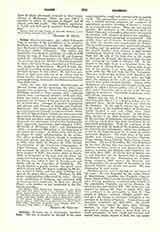

Salem (SALMANSWEILER), also called Salomonis Villa on account of the resemblance of its primitive buildings to Solomon‘s Temple, an abbey situated near the Castle of Heiligenberg, about ten miles from Constance, Baden (Germany). The abbey was founded by Gunthram of Adelsreute (d. 1138) in 1136 during the reign of Pope Innocent II and Emperor Lothair II. Gunthram also gave the Abbot of Lucelle the necessary lands for the first Cistercian monastery in Alsace, the latter being a foundation of Bellevaux, first daughter of Morimond. Blessed Frowin, formerly the travelling companion and interpreter of St. Bernard, became its first abbot. He had been professed at Bellevaux, and was of the colony sent to found Lucelle; hence have arisen misunderstandings, some maintaining, erroneously, that Salem was founded from Bellevaux.
Under the wise and prudent administration of Blessed Frowin and his successors, the abbey soon became very prosperous. Extensive and magnificent buildings, erected in three squares, and a splendid church were constructed between 1182 and 1311. Salem was noted as the richest and most beautiful monastery in Germany, being particularly renowned for its hospitality. Amongst its greatest benefactors and patrons were Conrad of Swabia and Frederick Barbarossa. The former placed the abbey under the special protection of himself and his successors—hence the title of “Royal Abbey” which was renewed several times under Barbarossa and his successors; Innocent II also took the abbey under his particular patronage. Its growth was continuous, and even after having made three important foundations—Raitenhaslach (1143), Maristella or Wettingen (1227), and Königsbrunn (1288)—it numbered 285 monks at the beginning of the fourteenth century. Its abbot, from 1454 on, was privileged to confer subdeaconship on his monks. The abbey gradually declined, though it numbered forty-nine priests and thirteen other choir religious in 1698, when Abbot D. Stephen (d. 1725) became Vicar-General of the Cistercian Congregation of Upper Germany. Caspar Oexle, who, as librarian, had increased the library to 30,000 volumes and a great number of MSS., was elected abbot in March, 1802; in September of the same year the abbey was suppressed and given to the Princes of Baden, while the library was added to that of Petershausen, and finally sold to the University of Heidelberg. The church became a parish church; the grand tower with its fifteen bells, the largest weighing 10,000 lbs., was destroyed (1805), and the other buildings were used as the grand duke’s castle. Eberhard, its fifth abbot, is honored as a Blessed of the order. He was made Archbishop of Salzburg, and entrusted with various important missions by the Holy See. Blessed Henry, a lay brother, is also mentioned in the Cistercian menology.
EDMOND M. OBRECHT

